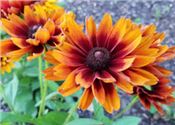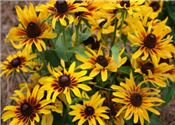Various Rudbeckia Selections Take Summer’s Heat In Stride
MISSISSIPPI STATE, MISS.
When Mississippi’s oppressive heat and humidity drive gardeners indoors, there’s one blooming beauty sure to brings us back outdoors: the Rudbeckia.
These flowers, also commonly known as black-eyed Susans, make gorgeous cut flowers for indoor use.
Rudbeckias produce an abundance of bright-yellow flowers, each with a dark, button-shaped cone in the center. These sunny-colored flowers have been recognized as Mississippi Medallion and All-America Selections winners in past years.
Plant all Rudbeckias in full sun for best flowering and color. They give peak performance in compost-amended and well-drained soils, but they tolerate poor, clay soils.
Although these plants are known and grown for their drought tolerance, dry conditions limit flowering. For best landscape performance, keep a consistent soil moisture for your Rudbeckias, and they will reward you with continued flowering.
Rudbeckias are all considered lower maintenance plants, but they need deadheading, which is the removal of the fading flowers to keep the plants blooming all summer.
There are several species for gardeners to choose from. Rudbeckia hirta, a Mississippi native wildflower, is a staple in naturalized areas and meadows. Black-eyed Susans are also reliable garden and landscape performers for the butterfly garden.
Some varieties are true annuals, others are true perennials, and the rest are somewhere in between. It really doesn’t matter which you choose because all will put on a summer show in the landscape.
Rudbeckia Indian Summer, Cherokee Sunset and Prairie Sun all make great cut flowers with their large blooms and strong stems.
Indian Summer has flowers that reach a whopping 9 inches across with a delicious-looking, rich chocolate-brown center cone. The flowers are displayed atop stiff, upright stems, creating a breathtaking sight along perennial color borders.
Cherokee Sunset has a blend of warm autumnal colors in a mix of single and double flowers, especially when grown in full sun. The blooms of Rudbeckia Prairie Sun are very distinctive. These bicolor flowers have orange petals tipped in bright, primrose-yellow with light-green centers.
Another variety to look for is Denver Daisy, which has flower petals of pure, bright yellow with variable splotches of dark red at the base.
An old standby that should not be overlooked is Rudbeckia Goldsturm. The multitudes of golden-orange flowers have dark-brown center cone. It has a clumping growth habit, making it a terrific choice for mass planting.
The Irish Eyes variety differs from other rudbeckias because it has emerald-green center cones instead of black or dark brown. This plant produces clear-yellow blooms from summer into fall and will grow up to three feet tall.
If you don’t have these perennials growing in your landscape, you need to rethink your garden plan for next year. These plants actually shine in our summer heat, refusing to wilt like both people and many plants in the heat of summer. ∆

The stiff, upright stems and 9-inch blooms of Rudbeckia Indian Summer create a breathtaking sight along perennial color borders.
Photo by MSU Extension/Gary Bachman

The golden yellow petals and dark red halo of Denver Daisy rudbeckia refuse to wilt in the hot summer landscape.
Photo by MSU Extension/Gary Bachman